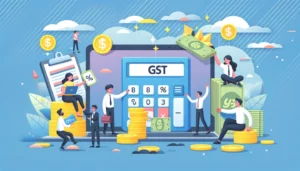Top Reasons for Implementation of GST in India
- 12 Aug 24
- 24 mins

Top Reasons for Implementation of GST in India
Key Takeaways
- CGST, SGST, and IGST: The central government collects CGST on intra-state sales, state governments collect SGST on intra-state sales, and the central and state governments jointly levy IGST on inter-state sales and imports.
- Elimination of Cascading Taxes by GST: GST removes the cascading effect of taxes by allowing businesses to claim input tax credit, ensuring tax is only paid on the value addition at each stage.
- Challenges Faced by Businesses under GST: Businesses grapple with understanding complex regulations, increased compliance requirements, and adapting to frequent changes in GST rules.
- GST's Impact on the Indian Economy: GST has streamlined taxation, increased compliance, expanded the tax base, facilitated ease of doing business, and reduced the tax burden on consumers.
- Variability of GST Rates Across States: GST rates are uniform across all Indian states, maintaining a single national market without tax rate discrepancies between states.
The introduction of the Goods and Services Tax (GST) signaled a significant turning point in the rapidly evolving Indian economy. The business landscape of the nation has undergone a considerable transformation with the introduction of the Goods and Services Tax (GST). Its consequences extend beyond revenue collection and tax compliance to include the cost of goods and services. Its objective is to consolidate under one roof the intricate tax system.
What is GST in India?
The Goods and Services Tax, or GST, is a multi-phase, destination-based tax system that represents a significant shift in India's taxation policy. The new approach aims to tax every value addition made to a product during its transition from production to consumption. Let's look at the essential elements of GST in order to better understand its goals and ramifications:

Multi-Stage
The term "multi-stage" refers to the characteristic of GST, where the tax is applied at every step of the production and distribution process. From the initial procurement of raw materials to the final sale to the consumer, GST encapsulates multiple transactions in the supply chain.
This ensures that the tax is integrated throughout the product's lifecycle, covering manufacturing, wholesaling, and retailing.
Value Addition
At the heart of GST lies the concept of "value addition." This principle ensures that the tax is levied only on the additional value created at each step of the supply chain. Value addition can be understood as the increase in value a product undergoes when it progresses from raw materials to finished goods.
By taxing only the value added at each stage, GST prevents the cascading effect of taxes, which was a significant drawback of the previous tax regime. This means that each entity in the supply chain can claim credits for the taxes paid on their purchases, ensuring that the final consumer is not burdened with the tax paid at earlier stages.
Destination-Based
The destination-based nature of GST signifies that the tax revenue accrues to the state where the goods or services are ultimately consumed rather than where they are produced.
Consistent with the objectives of a consumption-based tax system, this aspect of GST guarantees that tax benefits are distributed depending on state-by-state consumption patterns. In line with trends of national consumption, it encourages a more equal allocation of tax income.
By getting rid of several indirect taxes and enhancing the tax system's efficiency and transparency, this framework seeks to simplify the tax structure. Input tax credits flow smoothly and are encouraged to be used, which lowers total costs for both consumers and enterprises. The GST regime seeks to unify the vast Indian market and enhance trade and investment conditions by eliminating interstate tax barriers.
The Journey of GST in India
The concept of GST was first proposed in 2000, and it took 17 years of debate, planning, and restructuring before it was finally implemented on July 1, 2017. The intricacies of Indian taxes and the enormous efforts made to simplify them are reflected in this voyage.
The implementation of a unified tax system under a federal framework such as India is characterized by extensive talks, negotiations, and reaching an agreement among all parties. An in-depth look at the development of GST in India is provided below:
The Conceptual Foundation
In 2000, the Atal Bihari Vajpayee administration formed a committee to develop the GST law, which is when the idea was initially proposed. However, the journey of GST from a conceptual stage to its actual implementation spanned over 17 years, a period during which the proposal underwent numerous modifications to accommodate the diverse needs of a federal economy and address the concerns of various stakeholders.
Building Consensus
One of the most significant challenges in the journey of GST was building consensus among all Indian states. Given that GST proposed to replace state-level taxes with a unified national tax, concerns about loss of fiscal autonomy and revenue losses for some states were paramount.
Years of negotiations and discussions under successive governments were focused on creating a mutually agreeable framework that ensured compensation for potential revenue losses and a fair distribution of tax revenues.
Legislative Milestones
The formal legislative process for GST began in 2011 with the introduction of the 115th Constitutional Amendment Bill. However, it faced political hurdles and was not passed.
The momentum for GST didn't gain renewed focus until the NDA government under Prime Minister Narendra Modi came to power in 2014. Both houses of Parliament passed the 122nd Constitutional Amendment Bill in 2016, and more than half of the state legislatures ratified it later that year, paving the way for the implementation of GST.
Implementation
After years of preparation, GST was finally implemented on July 1, 2017, marking a historic day in India's economic landscape. A special midnight session of Parliament was held to commemorate the introduction of the Goods and Services Tax (GST), and prominent figures from all political and economic backgrounds were there.
This new tax regime drastically changed the way business was done in India by replacing several national and state levies with a single tax structure.
Post-Implementation Journey
The implementation of GST was not the end but the beginning of a new journey. The GST Council, a crucial decision-making body made up of the finance ministers of the federal and all state governments, made many changes to the GST rates and regulations during the post-implementation phase in response to real-world issues and input from consumers and companies.
Efforts to improve compliance, streamline the GST filing process, and make the tax system more business-friendly have defined this time frame.
Objectives Of GST

The objectives of GST were multifaceted, reflecting the government's ambition to foster a more efficient, transparent, and growth-oriented economy. Here are the key objectives behind the introduction of GST in India:
- To Eliminate the Cascading Effect of Taxes
One of the primary objectives of GST was to eliminate the cascading effect of taxes, also known as "tax on tax," which was prevalent in the pre-GST regime. Under the old system, each stage of the supply chain was taxed on the entire value, including taxes applied in previous stages, leading to an inflated burden on the end consumer.
GST, being a value-added tax, ensures that tax is paid only on the value addition at each stage, thereby reducing the overall tax burden on goods and services.
- To Create a Unified National Market
Prior to GST, India was a fragmented market, with each state imposing its own set of taxes and levies, leading to significant inter-state trade barriers.
With the elimination of several state and federal taxes, the GST sought to create a unified market that would allow products and services to be freely and fairly moved across state lines. For the purpose of increasing economic integration and providing chances for companies to compete, the achievement of this objective was a key element.
- To Simplify the Tax Structure
The pre-GST tax structure in India was notoriously complex, with a multitude of taxes levied by the central and state governments, including VAT, excise duty, service tax, and more.
The GST aimed at refining the confusion with a combination of a myriad of state and federal taxes into a singular tax. Businesses would find it simpler to abide by tax regulations as a result, and tax authorities and taxpayers would have less administrative work to do.
- To Enhance Tax Compliance
A simplified tax regime, combined with the technology-driven GST compliance system, aimed to improve tax compliance rates. With creating a robust input tax credit system and expediting the tax filing procedure, GST encourages businesses to abide with tax laws. This increases government income and widens the tax base.
- To Boost Economic Growth
With the goal of creating a more efficient tax system and reducing trade barriers, the GST aims to stimulate economic growth. Trade is facilitated, money is drawn, and business competition is heightened in monopolistic markets.
As a result, it is expected that this would foster innovation, increase productivity, and provide employment opportunities—all of which will contribute to the overall growth of the Indian economy.
- To Increase Government Revenues
The goal of GST is to increase the number of firms operating in the formal sector by streamlining the tax system and streamlining compliance, therefore broadening the revenue base.
It is implied that such measures would surely reduce tax evasion and raise government revenues both at the federal level and also at the state level due to enforcement effectiveness and a solid IT backbone.
- To Promote Transparency and Accountability
The GST system is designed to be transparent and accountable, with a clear trail of transactions through the digital compliance system.
This way of making tax operations clear will lead to a decreasing probability of corruption and tax evasion and thus the benefit of the system will be poured to the end users.
Advantages Of GST

The introduction of GST has several advantages, including simplification of the tax structure, increased transparency, expansion of the tax base, and improved compliance levels.
| Advantage | Description |
|---|---|
| Elimination of Cascading Tax Effects | GST eliminates the cascading effect of taxes, or tax on tax, ensuring that tax is only levied on the value addition at each stage of the supply chain. This reduces the overall tax burden on goods and services. |
| Unified National Market | By subsuming a majority of the central and state taxes into a single tax and allowing the free flow of goods and services across states, GST has created a unified national market, which enhances the ease of doing business. |
| Simplification of Tax Structure | GST merges multiple taxes into one, thereby simplifying the tax structure and making it easier for businesses to comply with tax regulations, reducing the administrative burden on businesses. |
| Increased Tax Compliance | Through its transparent and straightforward system, the GST framework aims to increase tax compliance. This is expected to increase tax revenues by bringing more businesses into the formal economy. |
| Higher Revenue Efficiency | GST improves revenue efficiency by widening the tax base and improving taxpayer compliance. This efficiency comes from the system's design to minimize exemptions and lower the overall tax rates. |
| Reduction in Economic Distortions | By providing full tax credit for inputs, GST reduces the hidden costs of doing business, thereby making Indian products and services more competitive in domestic and international markets. |
| Encouragement of Digitalization | The GST regime encourages digitalization of the tax process, from registration to filing returns and making payments, which enhances transparency, accountability, and ease of compliance. |
| Better Allocation of Resources | As GST is a consumption-based tax, it is levied where goods are consumed, leading to a more efficient and equitable allocation of resources, aligning with the "make in any state, sell in any state" ethos. |
| Increase in Employment | The expected growth in the economy due to GST implementation is likely to create more employment opportunities as businesses expand. |
Components of GST
GST is divided into three components:
- CGST GST (Central State Tax )
- SGST (State GST)
- IGST (Integrated GST)
The Goods and Services Tax (GST) in India is a comprehensive, multi-tiered, destination-based tax that has replaced many indirect taxes previously levied in the country. GST is structured around three main components, each catering to a specific facet of taxation within the federal structure of India.
These components are crucial for understanding how GST operates and ensuring that both the central and state governments are able to collect tax revenues on goods and services. Here are the components of GST:
Central Goods and Services Tax (CGST)
- Description: CGST is the component of GST collected by the Central Government on intra-state sales, i.e., sales within the same state. The CGST is applied to the transaction value of the goods and services, and it replaces the Central Excise Duty, Service Tax, and additional duties of customs at the national level.
- Revenue Sharing: The central government retains the CGST revenue.
State Goods and Services Tax (SGST)
- Description: SGST is the segment of GST levied by the state governments on intra-state sales. This means that when a transaction occurs within a single state, SGST is applicable alongside CGST on the same transaction.
- Revenue Sharing: The revenue from SGST goes to the state government where the goods or services are sold. It replaces taxes such as State VAT, Luxury Tax, Entry Tax, and Entertainment Tax at the state level.
Integrated Goods and Services Tax (IGST)
Description: IGST is charged on inter-state transactions of goods and services, as well as on imports. It is designed to ensure that states only have to deal with the state government for tax settlement, simplifying the tax system, especially for goods and services that move across state boundaries.
Revenue Sharing: The revenue collected under IGST is shared between the central and state governments as per the rates specified by the authorities. This mechanism ensures that the tax is collected in the state where the goods or services are consumed.
Additional Note
- Union Territory Goods and Services Tax (UTGST): In addition to these elements, Union Territories that lack their own legislature levy the Union Territory Goods and Services Tax (UTGST), which is comparable to the SGST. This ensures a uniform tax structure across states and Union Territories alike.
Tax Laws before GST
Before the implementation of the Goods and Services Tax (GST) on July 1, 2017, India had a complex and fragmented tax structure comprising various indirect taxes levied by both the central and state governments.
These taxes often led to a cascading effect, also known as the tax-on-tax effect, making compliance cumbersome and the tax structure inefficient. Here's an overview of the major tax laws that were in place before GST:
Central Taxes
- Central Excise Duty: Levied on the manufacture of goods within India, it was one of the primary sources of revenue for the Central Government.
- Service Tax: Imposed on the gross amount charged for the provision of services.
- Central Sales Tax (CST): Charged on the sale of goods between states, administered by the Central Government but collected by the state where the sale originated.
- Additional Customs Duty (CVD and SAD): Countervailing Duty (CVD) and Special Additional Duty (SAD) were customs duties on imported goods that were the same as Excise Duty and Value-Added Tax (VAT). They were meant to tax imports the same way as goods made in the country.
State Taxes
- Value Added Tax (VAT): A multi-point tax on the value addition to goods, applied at the state level. It replaced Sales Tax.
- Sales Tax: Charged on the sale of goods within the state, Sales Tax was replaced by VAT in most states.
- Luxury Tax: Imposed on luxury goods and services, as determined by the state governments.
- Entertainment Tax: Levied by state governments on every transaction related to entertainment services.
- Entry Tax: Collected by state governments on the entry of goods into a state from another state for use, sale, or distribution.
- Octroi and Local Body Tax: Levied on the entry of goods into a municipal area for use, consumption, or sale, mainly prevalent in some states.
Effect of GST on the Indian Economy
Positive Impact
- Simplification of Tax Structure: GST replaced a plethora of indirect taxes with a single tax, simplifying the tax structure and making it easier for businesses to comply. This simplification reduced the administrative burden on businesses, especially SMEs, and facilitated ease of starting and doing business in India.
- Increase in Tax Base and Revenue: By bringing more businesses under the tax regime and improving compliance through a simplified and transparent system, GST has significantly widened the tax base. This has led to an increase in tax collections over time, contributing to the government's revenue and enabling more robust public spending.
- Boost to Interstate Trade: The elimination of interstate barriers, like check posts and entry taxes, under GST has ensured the free flow of goods across state borders. This has not only reduced transportation costs and time but also promoted a unified national market, benefiting both businesses and consumers.
- Encouragement of the Digital Economy: GST's implementation necessitated a shift towards digital transactions and compliance mechanisms, encouraging the digital economy. Transparency and efficiency are promoted via the GST Network (GSTN), which makes online registration, tax payments, and return filing easier.
- Reduction in Cascading Effect of Taxes: By implementing the input tax credit mechanism, GST has minimized the cascading effect of taxes (tax on tax), making goods and services cheaper for consumers and reducing the cost of doing business for suppliers.
Negative Impact
- Initial Implementation Challenges: The initial rollout of GST was met with several challenges, including technical glitches in the GSTN portal, confusion over tax rates, and difficulties in understanding the new compliance requirements. Businesses, particularly small and medium-sized organizations (SMEs), experienced brief interruptions as a result of these concerns.
- Increased Operational Costs for Some Sectors: While GST aimed to reduce the overall tax burden, certain sectors experienced an increase in operational costs due to the higher tax rates under the new regime compared to the previous indirect tax structure.
- Compliance Burden on Small Businesses: Despite the intention to simplify the tax system, the transition to GST required businesses to upgrade their systems, invest in GST-compliant software, and acquaint themselves with the new compliance norms, imposing a financial and operational burden on small businesses.
Long-term Economic Effects
- Formalization of the Economy: GST has played a significant role in formalizing the Indian economy by bringing more businesses into the formal sector. Better regulation, more tax compliance, and the opening up of official credit channels for enterprises are all dependent on this formalization.
- Improvement in Competitive Position: The reduction in the overall tax burden on businesses and the elimination of interstate trade barriers under GST have improved the competitive position of Indian goods and services, both in domestic and international markets.
- Fiscal Consolidation: Tax payment of this type of tax and the implementation of mechanisms for efficient tax administration help the country reach the stage of fiscal consolidation, and as a result, the authorities may have more funds to invest in the areas of health, roads, education, and social programs by increasing public expenditure.
How Has GST Helped in Price Reduction?

The implementation of the Goods and Services Tax (GST) in India was aimed at making the tax system more efficient by eliminating the cascading effect of taxes and simplifying the complex structure of indirect taxation. One of the significant outcomes expected from GST was a reduction in the prices of goods and services due to the streamlined tax process and the elimination of multiple taxes.
Here's how GST has helped in price reduction, illustrated with an Indian example:
- Elimination of Cascading Effect
Before GST, the Indian tax system was plagued by the cascading effect, where taxes were levied on top of taxes previously paid. This meant that at every stage of the supply chain, from production to the final sale, taxes were paid on top of taxes, increasing the cost of goods and services for the end consumer.
GST replaced this system with a single tax from the manufacturer to the consumer, with the facility to claim credits on the tax paid at previous stages, effectively reducing the overall tax burden on goods and services.
Example: Consumer Electronics
Consider the example of consumer electronics, such as smartphones or televisions, which go through various stages of supply chain before reaching the end consumer. Under the pre-GST regime, these products were subjected to various taxes, like excise duty at the manufacturing stage, VAT at the state level, and sometimes additional entry taxes by different states.
- Pre-GST Scenario: Suppose a smartphone manufacturer produces a phone costing INR 10,000, on which excise duty (around 12.5%) and VAT (varying from 12% to 15% across states) are applicable. The effective price of the smartphone could escalate significantly by the time it reaches the consumer, due to the cascading effect of these taxes.
- Post-GST Scenario: With GST, all these taxes are subsumed into a single tax. Assuming a GST rate of 18% on electronics, the tax is now levied only on the value added at each stage and not cumulatively.
Importantly, each participant in the supply chain can claim a credit for the GST paid on their purchases (input tax credit), which reduces the tax burden and, consequently, the cost of the product. This system avoids the cascading effect and brings down the retail price of consumer electronics for the end consumer.
Price Reduction Mechanism through Input Tax Credit
The mechanism of Input Tax Credit (ITC) under GST allows businesses to reduce the taxes on their sales by the amount of tax they have already paid on their purchases. This means that if a manufacturer pays GST on raw materials, the tax paid can be deducted from the GST owed on the final product.
This input tax credit system ensures that the tax is effectively paid only on the value addition, not the entire value of the product, leading to a reduction in production costs which can be passed on to consumers in the form of lower prices.
- New Compliances Under GST
The Goods and Services Tax (GST) in India introduced a new tax regime that consolidated several older taxes into a single, unified system. This transition not only changed how taxes were calculated and collected but also brought about new compliance requirements for businesses.
The aim of these new compliances under GST is to streamline tax administration and increase transparency through the use of technology. Here’s a detailed look at the new compliances introduced under GST:
GST Registration
- Eligibility: Businesses with a turnover exceeding the threshold limit (currently INR 40 lakhs for goods and INR 20 lakhs for services, with some variations for special category states) are required to register under GST. Additionally, certain categories of businesses, irrespective of their turnover, need to register for GST.
- Process: The GST registration process is entirely online through the GST portal. It involves submitting business details, including PAN, business address, bank account details, and the nature of goods or services provided.
GST Return Filing
- Frequency and Types: Businesses registered under GST are required to file various returns periodically. The primary returns include:
- GSTR-1: For reporting sales transactions, filed monthly or quarterly, depending on turnover.
- GSTR-2A & 2B: auto-generated statements showing purchases and input tax credit for the recipient's reference.
- GSTR-3B: A monthly summary return for reporting consolidated details of sales, purchases, and input tax credit, used for making tax payments.
- Process: Filing is done online via the GST portal. The system is designed to auto-populate details wherever possible, reducing the filing burden on taxpayers.
E-Way Bills
- Requirement: For the movement of goods exceeding a specified value (currently INR 50,000), an electronic waybill or e-Way Bill must be generated through the GST portal. This applies to both inter-state and intra-state movement, subject to state-specific rules.
- Purpose: E-Way Bills ensure that goods being transported comply with GST law, aiming to curb tax evasion during transit.
- Input Tax Credit (ITC) Compliance
- Mechanism: Businesses can claim credit for the tax paid on their purchases (inputs) against the tax payable on their sales (outputs). However, compliance with certain conditions is required, such as ensuring the suppliers have filed their returns and paid the corresponding tax.
- Documentation: Proper documentation and reconciliation of purchase invoices with the GST returns filed by suppliers (reflected in GSTR-2A & 2B) are crucial for claiming ITC.
Digital Compliance and Record-Keeping
- Digital Invoicing: For businesses with a turnover above a certain limit, generating electronic invoices (e-Invoices) for every B2B transaction is mandatory. This system integrates real-time data with the GST portal.
- Record-Keeping: GST law mandates businesses to maintain detailed records of all transactions, invoices, tax payments, and returns filed for a minimum of six years.
Annual Return and Audit
- Annual Return (GSTR-9): All registered businesses must file an annual return summarizing the details of outward supplies, inward supplies, tax paid, and input tax credit availed during the financial year.
- Audit (GSTR-9C): Businesses with a turnover exceeding a specified threshold must submit a GST audit report, prepared by a certified chartered accountant, along with their annual return.
Conclusion
The Goods and Services Tax (GST) marks a significant milestone in India's economic reforms, streamlining the tax system and unifying the country under a single tax regime. By eliminating the cascading effect of taxes and simplifying compliance, GST has laid the foundation for a more transparent, efficient, and growth-driven economy.
Despite initial challenges, ongoing adjustments and improvements have shown the government's commitment to refining the system for the benefit of businesses and consumers alike. As the GST system matures, it promises to enhance India's competitiveness on the global stage, increase tax revenues, and stimulate economic growth.
The journey of GST is a testament to India's ambitious vision for a simplified and inclusive tax structure, supporting the nation's progress towards economic integration and development. In essence, GST not only reforms the tax landscape but also reinforces India's stride towards becoming a unified market, poised for future growth.
💡If you want to make the most of this PICE business payment solution for efficient GST payments on time, take a demo session now to see how it works for you.
 By
By 

















